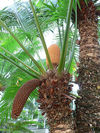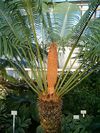Genus Cycas
Cycas is the type genus and the only genus currently recognised in the cycad family Cycadaceae.Species in the genus Cycas of plants
Cycas angulata - It is the largest Australian Cycas species, with arborescent and frequently branched stems growing to 5 m tall, and 15–25 cm in diameter. Older specimens lose the leaf base scars and gain a more checkerboard appearance. The leaves are 1.1-1.7 m long, pinnate with 180-320 leaflets, the leaflets 14–23 cm long and 4.5-6.5 mm wide, grey-green to glaucous; there are to 40 leaves in the crown. The leaf petioles are armed with spines in younger individuals with this trait being lost in older individuals.
Cycas apoa - It has erect stems up to 2.5 m tall. The leaves are hairy and orange at first, soon losing the hair and becoming glossy bright green, numerous and spreading, 1.8-2.5 m long. The petiole is armed with spines nearly over its entirety, with glabrous, glossy green leaflets angled forward about 70-80 degrees.
Cycas arenicola - The stems reach 1.5 m tall, with a diameter of 15-20 cm. The leaves are numerous, 0.9-1.6 m long, pinnate with 180-200 leaflets, glossy bright green above, pubescent beneath with brown pubescence, the leaflets are oriented 60-90 degrees forward without overlapping. The petiole is brown pubescent, 25-35 cm long, armed with spines.
Cycas armstrongii - The stems reach 3 m tall, with a diameter of 5–11 cm. The leaves are deciduous in the dry season , 55–90 cm long, slightly keeled or flat, pinnate with 100-220 leaflets; the leaflets densely orange-pubescent at first, then glossy bright green above, light green below, 5.5–14 cm long and 4.5–8 mm wide, angled forward at 40 degrees. Mature plants have around 50 leaves in the crown.
Cycas arnhemica - The stems are erect, growing to 1.5-2.5 m tall. The leaves are numerous, flat, 70-160 cm long, pinnate, with 160-260 leaflets; the new young leaves are deep white tomentose at first, becoming bright to dark green, moderately glossy above, the down often persisting on the underside.
Cycas badensis - The stems grow up to 8 m tall. The leaves are numerous, 1-1.2 m long, pinnate, with 200-230 leaflets, the leaflets 11-22 cm long and 5-7.5 mm wide. The emerging new leaves are densely orange-brown tomentose, becoming bright green and moderately glossy on the upper side, lighter green on underside.
Cycas balansae - It has a subterranean, unbranched stem 12–20 cm in diameter, bearing 4-9 leaves, each leaf 1.2-2.6 m long, pinnate with 90-160 leaflets, and armed with spines along the petiole. The leaflets are papery in texture, and angled forward at 80 degrees.
Cycas basaltica - The stems grow to 2 m tall and 15-23 cm in diameter, with a swollen base and an enlarged subterranean structure. There are 30 or more leaves in the crown, forming a bowl shaped, inward facing leaf crown, each leaf 80-125 cm long, pinnate, with 140-210 leaflets. Younger plants have spiny petioles, with older specimens losing this trait. The leaflets are covered with a dense layer of silver hairs, angled forward at 70-80°. The basal leaflets are reduced to spines, similar to Cycas revoluta. The taproot is contractile, and tends to pull crown downwards.
Cycas beddomei - Superficially similar to Cycas revoluta, it has erect, solitary stems. There are 20-30 leaves in the crown, each leaf 90 cm long, stiff, lanceolate, pinnate, with 50-100 pairs of leaflets, these 10-17.5 cm long and 3–4 mm wide, and angled forward at 45 degrees; the leaf petiole bears minute spines.
Cycas bougainvilleana - The stems are erect, up to 5 m tall, with a crown of numerous leaves. The leaves are 2.4-2.7 m long, pinnate, with 130-260 leaflets; they are densely white to orange tomentose at first, eventually glabrous, glossy bright green. The leaflets are 25-34 cm long and 13-18 mm wide, and angled forward at 60-80° degrees. The petiole is sometimes armed with spines, and terminates in a spine or pair of leaflets.
Cycas brunnea - The stems grow to 2–5 m tall, with numerous leaves in the crown. The leaves are 1.2-1.7 m long, glabrous with age, pinnate, with 160-240 leaflets, the leaflets 17–27 cm long and 6-7.5 mm wide. The petioles are covered in brown tomentum and armed with sharp spines.
Cycas cairnsiana - The stems grow to 2-5 m tall and 12-16 cm diameter, with swollen base. The leaves are dark orange-brown tomentose on emerging, then glaucous blue-green and glabrous with age, 60-110 cm long, bowed, keeled, pinnate, with 180-220 leaflets, the leaflets 8-18 cm long and 2-4 mm wide. The petioles are 18-27 cm long, and armed with sharp spines.
Cycad - The stems are erect, 2-5 m tall and 16-22 cm diameter. The leaves are variably deep green and glabrous to white tomentose above, and persistently white tomentose below, 60-130 cm long, pinnate, with 210-410 leaflets. The leaflets are 5-12 cm long and 2-4 mm wide, and lie flat either side of the leaf stem . The petioles are 18-30 cm long, and armed with sharp spines at the base.
Cycas campestris - The stems are erect, up to 2.5 m tall and 20 cm diameter. The leaves are orange tomentose on emerging, soon becoming bright glossy green and glabrous, 80-170 cm long, pinnate, with 120-230 leaflets. The leaflets are 8.5-16 cm long and 5-8 mm wide, and lie flat or in a shallow 'v'-shape on either side of the leaf stem. The leaf petioles are 15-90 cm long, and armed with sharp spines at the base.
Cycas canalis - The stems are erect, growing to 3-5 m tall and 7-14 cm diameter. The leaves are blue-green fading to green, 60-105 cm long, pinnate, with 100-170 leaflets. The leaflets are 10-20.5 cm long and 4.5-8 mm wide, and lie flat or in a shallow 'v'-shape on either side of the leaf stem. The petioles are 15-25 cm long, and armed with sharp spines for most of their length.
Cycas chamaoensis - Female cones closed type, sporophylls 13–18 cm long with yellow to gray tomentose. 2-4 ovules per sporophyll. Lamina is long, almost circular, with numerous lateral spines. Sarcotesta 3 mm thick, and yellow in color, with smooth sclerotesta. Male cones solitary and erect, spindle shaped to narrow ovoid, 50–60 cm long, 12–13 cm in diameter, with orange color. Prominent apical spine present.
Cycas media - Cycas media is a palm-like tall shrub native to woodlands of Queensland, Australia. The leathery, thick leaves are divided and grow from the center in a palm-like arrangement. All plant parts are considered highly toxic. However, the seeds are eaten by Aborigines after careful and extensive preparation to remove the toxins.
Cycas micronesica - Cycas micronesica is threatened by an introduced insect pest, the diaspidid scale Aulocapsis yasumatsui, first recognised in Guam in December 2003.
Cycad - Cycas pectinata is found in north eastern part of India. It is the 4th Cycas discovered. It grows 3-40 feet tall and has very large ovoid male cones.
Cycas pruinosa - This species is distinguished by its narrow glabrous leaflets with strongly recurved margins; its long, slender microsporangiate cones; and its long megasporophylls with long, sterile apices. It has a stout, erect trunk, around 2.5 m tall and 30 cm diameter, which is crowned with arching fronds, distinctly curved from the apex and V-shaped in cross-section. Glaucous leaf waxes may be either present or absent, causing plants to be either blue or green in overall appearance. It is suited to tropical regions which have a seasonally dry climate.
Sago Cycad - This very symmetrical plant supports a crown of shiny, dark green leaves on a thick shaggy trunk that is typically about 20 cm in diameter, sometimes wider. The trunk is very low to subterranean in young plants, but lengthens above ground with age. It can grow into very old specimens with 6–7 m of trunk; however, the plant is very slow-growing and requires about 50–100 years to achieve this height. Trunks can branch multiple times, thus producing multiple heads of leaves.
Cycas rumphii - 'Queen Sago' alludes to the name 'King Sago' given to the related Cycas revoluta, as well as to its use as a source of edible starch. The specific epithet rumphii honours the German-born Dutch naturalist Georg Eberhard Rumphius , who served first as a military officer with the Dutch East India Company in Ambon, then with the civil merchant service of the same company.
Cycas taitungensis - Cycas taitungensis is a species of genus Cycas, native to Taitung, Taiwan. C. taitungensis is one of the evergreen trees and can grow up to about 2 meters. It was listed by the IUCN Red List of Threatened Plants in category VU. The species was not described until 1994, but its specimens was once misapplied as the type of species Cycas taiwaniana, which is not really distributes in Taiwan according to the further researches.
Cycas taiwaniana - Cycas taiwaniana is a species of genus Cycas. The species is native to Guangdong, Guangxi and Fujian of China. Although the specific name of C. taiwaniana is derived from "Taiwan", where the original type specimens was found, it is not naturally distributes in Taiwan. Instead of C. taiwaniana, the original type specimens that was used for describing "C. taiwaniana", had been reclassified under another species named Cycas taitungensis.






